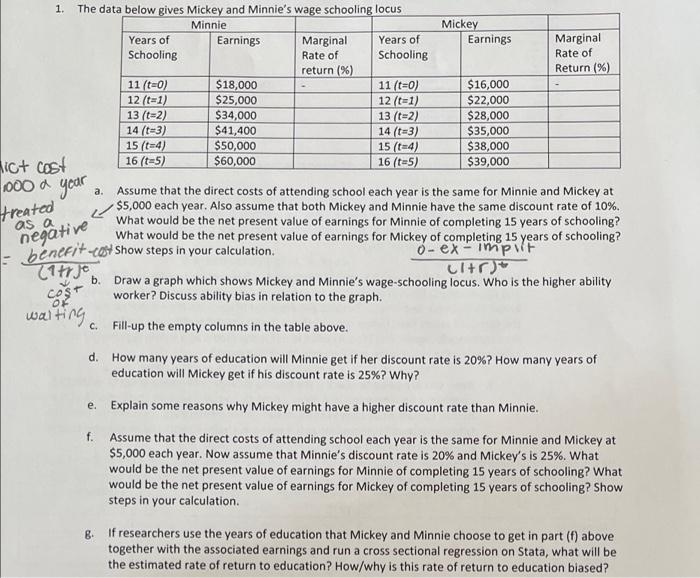1. The data below gives Mickey and Minnie's wage schooling locus Minnie Mickey Years of Earnings Marginal Years of Earnings Marginal Schooling Rate of Schooling Rate of return (%) Return (%) 11 (t=0) $18,000 11 (t=0) $16,000 12(t+1 $25,000 12(t-1) $22,000 13 (t=2) $34,000 13 (t=2) $28,000 14 (3) $41,400 14 (t=3) $35,000 15 (4) $50,000 15 (t=4) $38,000 lict cost 16 (5) $60,000 16 (5) $39,000 000 a Assume that the direct costs of attending school each year is the same for Minnie and Mickey at $5,000 each year. Also assume that both Mickey and Minnie have the same discount rate of 10%. What would be the net present value of earnings for Minnie of completing 15 years of schooling? What would be the net present value of earnings for Mickey of completing 15 years of schooling? benefit-cost show steps in your calculation. 0-ex-impi 21trje citr) b. Draw a graph which shows Mickey and Minnie's wage-schooling locus. Who is the higher ability worker? Discuss ability bias in relation to the graph. ON waiting C. Fill-up the empty columns in the table above. year a. Hreated as a negative d. How many years of education will Minnie get if her discount rate is 20%? How many years of education will Mickey get if his discount rate is 25%? Why? e. Explain some reasons why Mickey might have a higher discount rate than Minnie. f. Assume that the direct costs of attending school each year is the same for Minnie and Mickey at $5,000 each year. Now assume that Minnie's discount rate is 20% and Mickey's is 25%. What would be the net present value of earnings for Minnie of completing 15 years of schooling? What would be the net present value of earnings for Mickey of completing 15 years of schooling? Show steps in your calculation 8 If researchers use the years of education that Mickey and Minnie choose to get in part (1) above together with the associated earnings and run a cross sectional regression on Stata, what will be the estimated rate of return to education? How/why is this rate of return to education based? 1. The data below gives Mickey and Minnie's wage schooling locus Minnie Mickey Years of Earnings Marginal Years of Earnings Marginal Schooling Rate of Schooling Rate of return (%) Return (%) 11 (t=0) $18,000 11 (t=0) $16,000 12(t+1 $25,000 12(t-1) $22,000 13 (t=2) $34,000 13 (t=2) $28,000 14 (3) $41,400 14 (t=3) $35,000 15 (4) $50,000 15 (t=4) $38,000 lict cost 16 (5) $60,000 16 (5) $39,000 000 a Assume that the direct costs of attending school each year is the same for Minnie and Mickey at $5,000 each year. Also assume that both Mickey and Minnie have the same discount rate of 10%. What would be the net present value of earnings for Minnie of completing 15 years of schooling? What would be the net present value of earnings for Mickey of completing 15 years of schooling? benefit-cost show steps in your calculation. 0-ex-impi 21trje citr) b. Draw a graph which shows Mickey and Minnie's wage-schooling locus. Who is the higher ability worker? Discuss ability bias in relation to the graph. ON waiting C. Fill-up the empty columns in the table above. year a. Hreated as a negative d. How many years of education will Minnie get if her discount rate is 20%? How many years of education will Mickey get if his discount rate is 25%? Why? e. Explain some reasons why Mickey might have a higher discount rate than Minnie. f. Assume that the direct costs of attending school each year is the same for Minnie and Mickey at $5,000 each year. Now assume that Minnie's discount rate is 20% and Mickey's is 25%. What would be the net present value of earnings for Minnie of completing 15 years of schooling? What would be the net present value of earnings for Mickey of completing 15 years of schooling? Show steps in your calculation 8 If researchers use the years of education that Mickey and Minnie choose to get in part (1) above together with the associated earnings and run a cross sectional regression on Stata, what will be the estimated rate of return to education? How/why is this rate of return to education based







